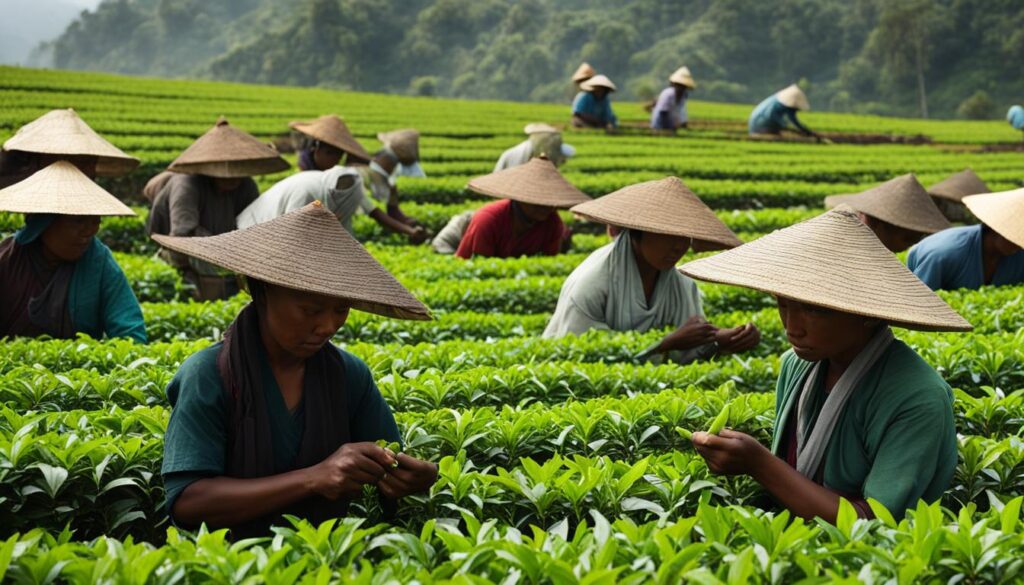Brew Your Own: The Ultimate Guide to Growing Tea at Home is a comprehensive book written by Christine Parks and Susan Walcott. Whether you have a spacious backyard or a small home garden, this ultimate guide will equip you with the knowledge and skills to cultivate and brew your own herbal tea.
The book begins with a fascinating exploration of the history and geography of tea, offering insights into its origins and cultural significance. It then delves into the botany of the tea plant, providing a deeper understanding of its growth patterns and requirements. From there, the guide offers practical advice on every aspect of home tea cultivation, from site planning and soil preparation to sourcing and propagation.
With step-by-step instructions and expert tips, you’ll learn how to raise and maintain healthy tea plants, ensuring a bountiful harvest of fresh leaves. The guide also delves into the techniques of harvesting and processing tea, allowing you to experience the satisfaction of transforming your homegrown leaves into exquisite brews.
Transform your home garden into a personal tea haven and savor the delights of brewing your own herbal tea with Brew Your Own: The Ultimate Guide to Growing Tea at Home.
Key Takeaways:
- Growing your own tea at home provides full control over cultivation to ensure organic, chemical-free plants.
- Homegrown tea offers an opportunity to experiment with various flavours and create unique blends.
- The book recommends different tea varieties and provides insights into their growing conditions and requirements.
- Harvesting and processing tea leaves are essential steps in creating exceptional brews.
- The guide offers tips and tricks for successful tea cultivation and brewing in different environments.
The Benefits of Homegrown Tea
Growing your own tea at home comes with numerous benefits. Firstly, it allows you to have full control over the cultivation process, ensuring that you can grow tea plants organically without the use of harmful pesticides or chemicals. This promotes a healthier and more sustainable approach to gardening. Additionally, homegrown tea provides the opportunity to experiment with different tea varieties and flavors, allowing you to discover unique blends and tailor your herbal tea to suit your taste preferences. Furthermore, the process of growing and harvesting tea can be a rewarding and enjoyable hobby, providing a sense of satisfaction and connection to nature. The comprehensive garden guide in the book will help you navigate through the process of homegrown tea cultivation and brewing.
With The Ultimate Guide to Growing Tea at Home, you’ll learn everything you need to know about cultivating tea plants in your own garden. From selecting the right tea plants to creating the perfect growing environment, this book serves as your go-to resource for successful, organic tea gardening. Whether you have a small backyard or a spacious garden, the guide offers practical tips and techniques for every type of home garden. You’ll discover how to care for your tea plants throughout the seasons, ensuring they thrive and produce abundant leaves for brewing.
Homegrown tea is not only a delight for the taste buds but also a source of pride and satisfaction. Imagine inviting friends over for a cup of tea made from your very own homegrown leaves. It’s a unique experience that showcases your dedication to organic gardening and the art of brewing. Moreover, with a diverse range of tea varieties, you can create your own signature blends, adding a personal touch to every cup. As you sip on your homemade herbal tea, you’ll savor the flavors and aromas that you nurtured from seedlings to steeped perfection.
The Benefits of Homegrown Tea:
- Control over cultivation process and organic gardening
- Experimentation with flavors and unique tea blends
- Rewarding hobby and sense of connection to nature
- Comprehensive garden guide for successful cultivation and brewing
“Growing tea plants at home allows individuals to enjoy a cup of tea knowing exactly how it was grown, harvesting the leaves when they are at peak freshness, and experiencing the satisfaction of cultivating their own herbal tea leaves.” – Christine Parks and Susan Walcott
Cultivating Tea Varieties at Home
The book provides a detailed list of recommended tea varieties that can be successfully cultivated at home. It includes information on the specific growing conditions, soil requirements, and agro-climatic considerations for each variety. Whether you want to grow green tea, black tea, white tea, or oolong tea, the guide will give you the necessary insights and instructions on how to plant, nurture, and harvest these different tea varieties. It also offers tips on easy-to-grow herbs that can be used for blending with tea or enjoyed on their own. With this knowledge, you can create a diverse and flourishing tea garden in your own backyard.
| Tea Variety | Growing Conditions | Soil Requirements | Agro-climatic Considerations |
|---|---|---|---|
| Green Tea | Sunny location, partial shade | Well-drained acidic soil | Requires cooler climates, certain cultivars can tolerate warmer temperatures |
| Black Tea | Sun to partial shade | Well-drained loamy soil | Thrives in warm climates, needs a frost-free period for optimal growth |
| White Tea | Sun to partial shade | Well-drained sandy soil | Prefers cooler temperatures, requires humidity and protection from strong winds |
| Oolong Tea | Partial shade to shade | Well-drained fertile soil | Best grown in subtropical to mild temperate climates, requires consistent moisture |
Harvesting and Processing Tea Leaves

Harvesting and processing tea leaves is a crucial step in the journey of growing your own tea. To ensure the optimal flavor and quality of your homegrown tea, it’s important to follow the right techniques and timing. “Brew Your Own: The Ultimate Guide to Growing Tea at Home” offers detailed instructions on how to harvest tea leaves and maximize their taste.
When it comes to harvesting tea leaves, timing is everything. The book reveals the ideal stage at which to pluck the leaves to achieve the desired flavor profile. Whether you’re growing green tea, black tea, white tea, or oolong tea, understanding when to harvest is key to capturing the distinctive characteristics of each variety.
To create the unique flavors found in different types of tea, the book also delves into the art of processing tea leaves. It explores various techniques for withering the leaves, rolling them, and allowing them to oxidize. By following these methods, you’ll be able to bring out the full potential of your homegrown tea leaves.
Here is an overview of the different processing techniques discussed:
- Withering: This process involves allowing the freshly harvested leaves to lose moisture, which affects the taste and aroma of the final tea product.
- Rolling: Rolling the leaves helps to shape them and break down the cell walls, which promotes oxidation and affects the flavor development.
- Oxidation: Depending on the type of tea you’re making, the book provides guidance on the optimal level of oxidation required to achieve the desired flavor profile.
- Drying: The final step involves drying the processed leaves to preserve their quality and extend their shelf life.
By mastering the techniques of harvesting and processing tea leaves, you’ll be able to create a truly personalized tea experience. Regardless of whether you prefer a delicate and grassy cup of green tea or a robust and bold cup of black tea, the satisfaction of brewing and enjoying your own homegrown tea is unparalleled. With the knowledge and guidance provided in this guide, you can turn your home garden into a haven for tea enthusiasts.
“The art of harvesting and processing tea leaves lies in striking the right balance between timing and technique. Each step plays a crucial role in shaping the flavor and character of the final cup. With ‘Brew Your Own: The Ultimate Guide to Growing Tea at Home’, you’ll gain the expertise needed to produce teas that rival those found in commercial establishments.” – Christine Parks, co-author
Now that you’re equipped with the knowledge of harvesting and processing tea leaves, it’s time to explore the various brewing techniques and creative uses for your homegrown leaves. Section 5 of this guide provides valuable tips and insights on successful tea cultivation and brewing, ensuring that you make the most of your home garden and enjoy the full potential of your herbal tea.
Tips for Successful Tea Cultivation and Brewing
When it comes to cultivating and brewing your own tea at home, there are a few important tips and tricks to keep in mind. This comprehensive garden guide not only teaches you the art of growing tea, but also provides valuable insights into successful cultivation and brewing techniques.
For those with limited space or wanting to grow tea in pots, the book offers guidance on adapting the cultivation process to different environments. From choosing the right soil and providing proper plant nutrition to managing pests organically, you’ll learn how to create the ideal conditions for your tea plants to thrive.
In addition to cultivation advice, the book also features simple and creative recipes that highlight the flavors of tea. Whether you’re looking to infuse your culinary creations with the delicate notes of green tea or experiment with bold and robust black tea flavors, you’ll find inspiration and guidance within the pages of this guide.
With this wealth of knowledge, you’ll have all the tools necessary to embark on your own tea cultivation and brewing journey. From nurturing your tea plants to harvesting and processing the leaves, this garden guide is your key to creating a flourishing home garden and enjoying the satisfaction of brewing your very own herbal tea.
FAQ
What is Brew Your Own: The Ultimate Guide to Growing Tea at Home?
Brew Your Own: The Ultimate Guide to Growing Tea at Home is a comprehensive book written by Christine Parks and Susan Walcott. It covers all aspects of growing and cultivating tea in your own home garden, providing practical advice and guidance.
What are the benefits of growing your own tea at home?
Growing your own tea at home allows you to have full control over the cultivation process, ensuring organic gardening practices without the use of harmful pesticides or chemicals. It also provides the opportunity to experiment with different tea varieties, flavors, and blends, promoting a healthier and more sustainable approach to gardening.
What tea varieties can be successfully cultivated at home?
The book provides a detailed list of recommended tea varieties, including green tea, black tea, white tea, and oolong tea, along with information on the specific growing conditions, soil requirements, and agro-climatic considerations for each variety.
How do I harvest and process tea leaves?
The book provides detailed instructions on when and how to harvest tea leaves to ensure optimal flavor and quality. It covers different techniques for plucking, withering, rolling, and processing the leaves to create the characteristic flavors of each tea variety.
What are some tips for successful tea cultivation and brewing at home?
The book offers a wealth of tips and tricks, including guidance on special circumstances such as growing tea in pots or limited spaces. It also provides advice on soil preparation, plant nutrition, and pest control, promoting organic and sustainable gardening practices. Additionally, the book features simple and creative recipes that highlight the flavors of tea.

